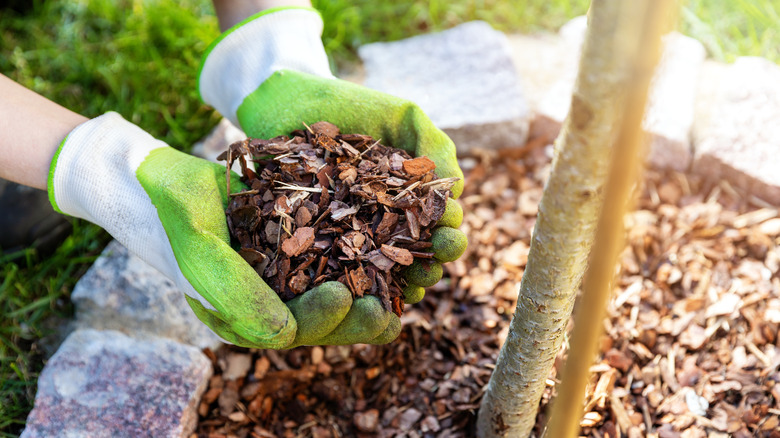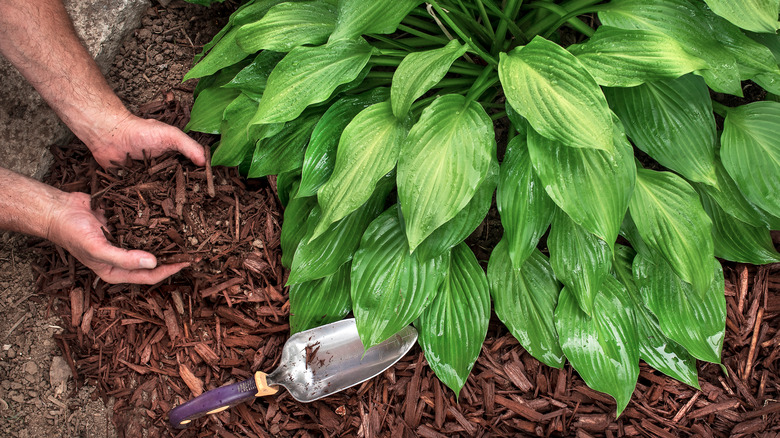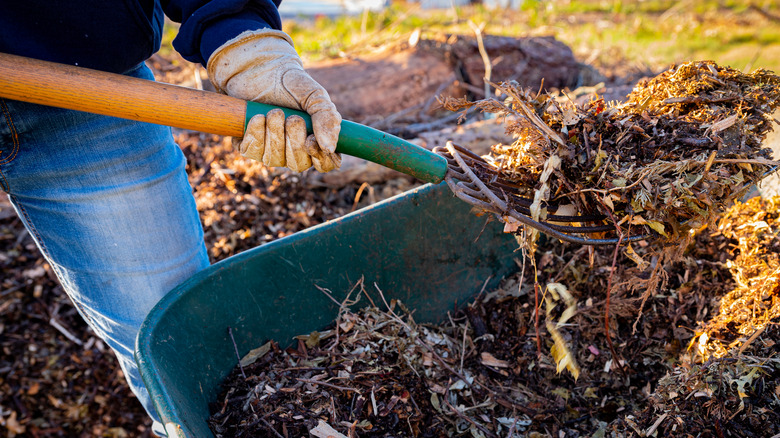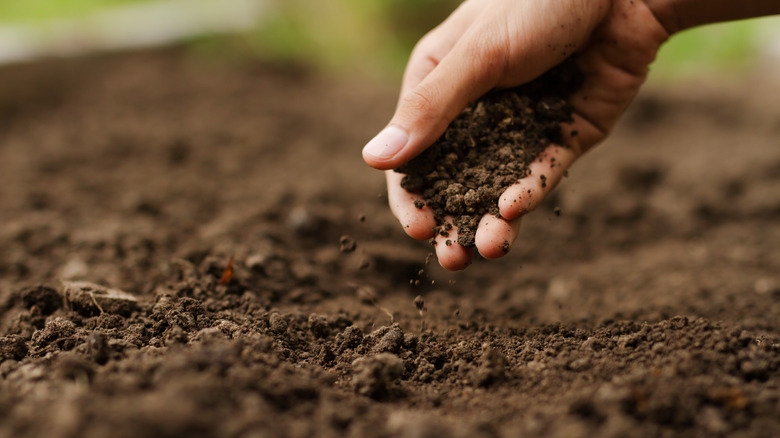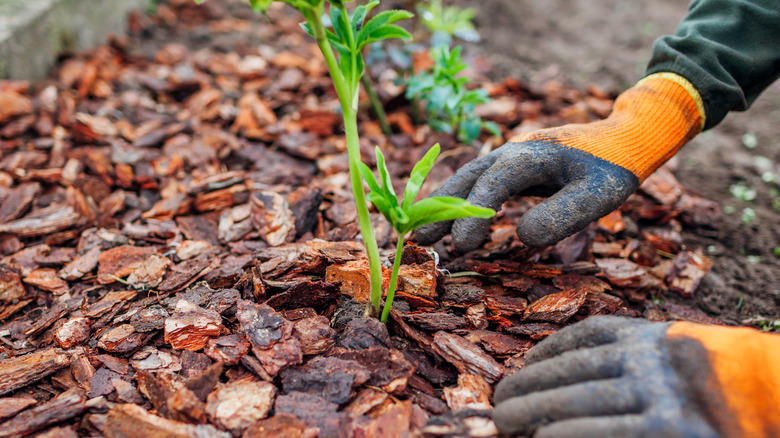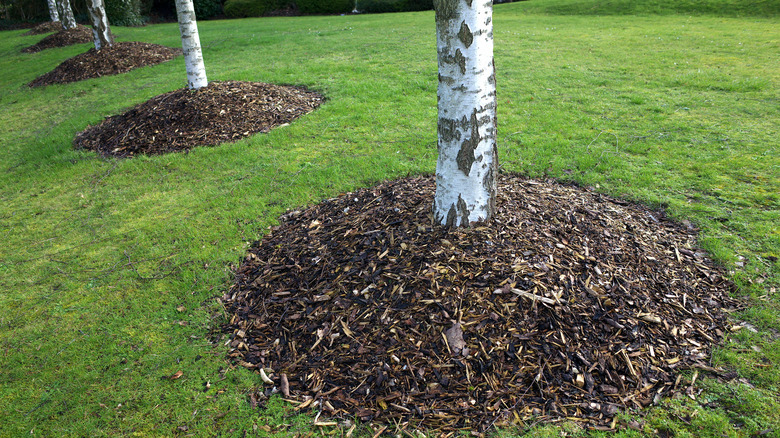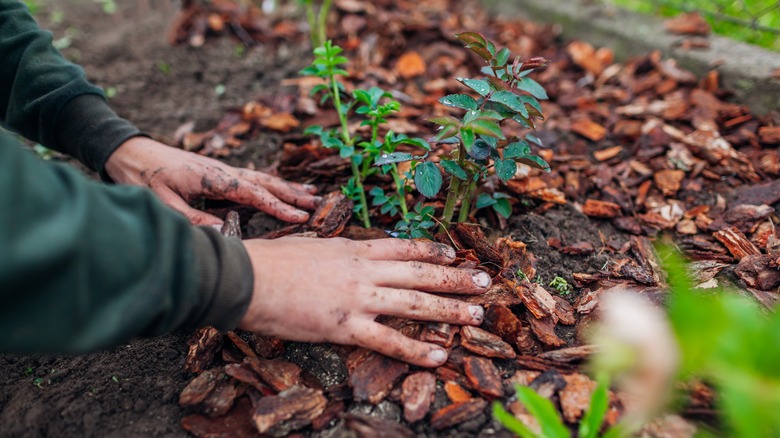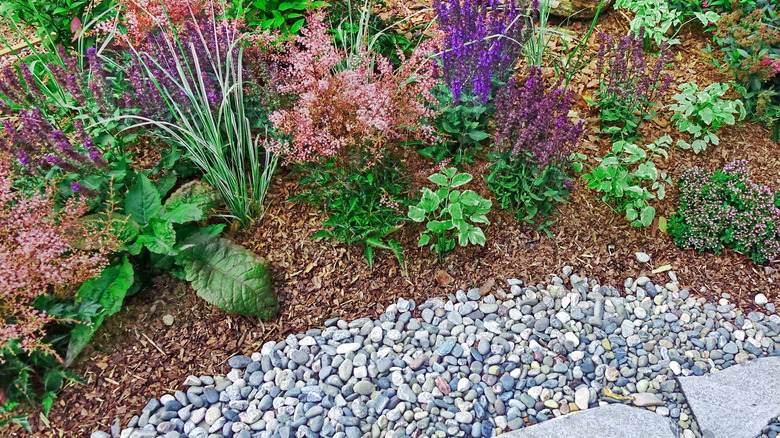7 Genius Mulching Tips To Makeover Your Garden
Even the most novice gardeners likely know that mulch helps grow and protect their plants, and because of this, many choose to reap its benefits all year long. According to Almanac, using mulch in your garden during the winter months helps protect your plants by preventing soil erosion. Then, in the spring, this compost type provides essential nutrients to the soil and is great at keeping weeds at bay and helping your plant get enough water.
With all the benefits that mulching provides plants and soil, using it in your garden seems like a no-brainer. However, simply throwing it into your garden won't benefit your plants much, and in fact, using mulch the wrong way, in the wrong spot, or in the wrong amount can actually do your flora more harm than good. Following a few tips and tricks for using mulch in your garden properly and effectively will help your plants and soil reap all the benefits and protection that this compost type offers.
Use the right amount
Knowing how much mulch to use in your garden is the first step in applying it to help the fauna thrive. Not using enough won't allow it to be nearly as effective as it could be, while using too much can cause your plants to weaken and require more nutrients and water as it encourages their root systems to remain shallow, according to Angi.
Mulch should be kept from 2 to 3 inches thick to ensure you have enough for your plants to reap the benefits but not too much to where your flora is suffocated and buried under it. Too much of this compost type prevents the roots from receiving vital access to water and oxygen, Almanac explains. Almanac also notes that when it comes to knowing how much to buy for your garden, you will need to calculate 18 cubic feet of mulch per 100 square feet. So, for example, if you intend to have 3 inches deep coverage, you want to purchase 27 cubic feet of mulch.
Use the right kind in the right place
Not all mulch is created equal, so knowing where and when to use specific types of this compost in your garden is important. Wood chips are perhaps the most common variety since Good Housekeeping notes that it works well and looks good in nearly any part of your lawn or garden (aside from your vegetable garden since it can get in the way of you digging beds every year). Wood chips look best in garden pathways, flower beds, and shrub borders.
Shredded leaves and grass clippings are also popular forms of mulch because they are so readily available in nature, per Almanac. However, wet grass clippings or shredded leaves can accumulate and rot, making a mess and depriving your plant of oxygen and water. Because of this, you should only use dry leaves or grass clippings and air the mulch out or replace it when it becomes too saturated.
Compost mulch is also a great option, especially for those who already collect compost, since it is so easily accessible. Almanac notes, however, that this type needs to be replenished quicker than other mulch kinds, so it may be more effectively used when spread thinly or used alongside other fertilizer types. Straw and hay are also easily-accessible and inexpensive mulching options, though Almanac notes that this mulch type can easily blow away in the wind, so it is best used in areas with other plants to block the wind.
Test your soil
Testing the acidity and nutrient consistency of the soil in your garden can help you determine which nutrients your garden lacks and if the pH level is suitable for plant growth — all of which will help you understand better what type of mulch you need to buy for best results. Angi reports that there are various at-home soil testing kits on the market, with the most basic beginning at about $15.
Nitrogen is an essential nutrient for plant health and growth, so if you test your soil and the nitrogen levels read low, Angi recommends using mulch in the form of horse manure and supplementing it with bone meal, horn meal, hoof meal, or feather meal. Manure is also an excellent option for your soil if it tests low for phosphorus or if the ground simply isn't all that great. If your soil tests low in potassium, compost mulch can help bring those levels back up.
Testing your soil and determining whether it is alkaline, neutral, or acidic can also help determine which type of fertilizer you should be using. And as Grow Cook Learn recommends, aim to keep the pH level of your soil as neutral as possible — which is a 7 on the pH scale of 1 to 14 (with 1 being the most acidic). Conversely, if your soil has a high pH level, using pine bark mulch can help lower it, as it is much more acidic than other forms of fertilizer.
Apply mulch twice a year
You should add mulch to your garden once in the spring after the ground thaws, and then add a second layer after the ground freezes in late fall, per Angi. Adding the second layer of fertilizer helps add an extra barrier of protection for your plants against the harsh winter elements.
According to Almanac, you should start fresh with all new mulch every year and remove all the old winter compost when it comes time to add it again in the spring. This will help encourage new growth and allow your plants to breathe. However, before laying down new fertilizer, ensure you thoroughly weeded your garden. Good Housekeeping notes that this compost should always be laid after the area has been removed of weeds to ensure that it has a better chance of preventing unwanted weeds from coming through.
So while applying the fertilizer a little thicker in the spring can help prevent weed growth, if your garden is still prone to pesky weeds, double mulching with newspaper can help stop them in their tracks. To double mulch, put your plants in the ground and water them thoroughly before spreading newspaper around the base and topping it off with compost. This added layer of protection will discourage roots from growing through the surface.
Don't volcano mulch
When people mulch around trees, they often make the mistake of concentrating and packing it directly around the trunk and not dispersing it, causing the fertilizer to create a mound around the base of the tree that looks like a volcano.
Per Almanac, these mulch volcanoes can cause rot around the trunk and roots by over-saturating the soil and preventing oxygen from reaching the tree. Angi recommends sticking to the standard rule of having fertilizer no more or less than 2 to 3 inches thick and loosely spreading it out past the tree's base to as far out as the branches extend. This general rule of thumb also applies to mulching around shrubs, as people often tend to use the volcano method with shrubs as well.
PennState University recommends applying the compost several inches away from the tree's trunk and allowing the area where the trunk meets the soil to be completely exposed. This will help prevent overcrowding and promote the health of the tree.
Use mulch on wet soil
Mulch is most effective when laid on top of wet soil, as one of the main purposes of this compost type is to lock in soil moisture. According to SFGate, it is difficult for water to penetrate through it, meaning that unless the soil beneath your compost is already wet, it will have a difficult time getting water.
The same rule applies to fertilizer as it does water, and Angi recommends fertilizing the soil before mulching as well to ensure any fertilizer you intend to use doesn't have to penetrate the mulch. Angi also recommends laying the compost immediately after watering and fertilizing to limit the water and fertilizer's evaporation window.
Mulching immediately after watering and fertilizing can also help prevent soil erosion and runoff, per HGTV, as bare soil is far more susceptible to these issues. In fact, HGTV says that Virginia Tech graduate student David Mitchell discovered that soil with mulch loses about five times less sediment than bare soil does. In addition, preventing runoff and erosion is beneficial to your plants and soil, but also to the environment, as fertilizer overflow can be harmful to groundwater.
Use mulch as an accent
In addition to having great practical and functional value, mulch also has aesthetic and retail value, and many people choose to use it in their garden simply for the way it looks. HGTV suggests utilizing colored types in your lawn or garden to add to your home's exterior aesthetic, especially hues that complement and highlight your residence's features and colors or even other plants you have growing nearby.
According to HGTV, Jeremy Becker, owner of FireFly Landscapes in Kansas City says that brown or red pine mulch complements brick houses excellently. If you specifically want to highlight your garden and other aspects of your landscaping instead of the exterior facade of your home, using a dark-colored type can create a dramatic contrast and make your landscaping pop. Mulch can also be used to establish a visual barrier between different plants, shrubs, or trees in your lawn or garden and can break up various landscaping features or sections.
